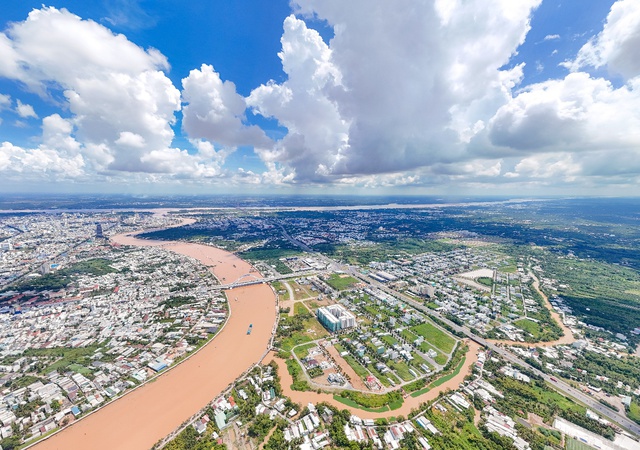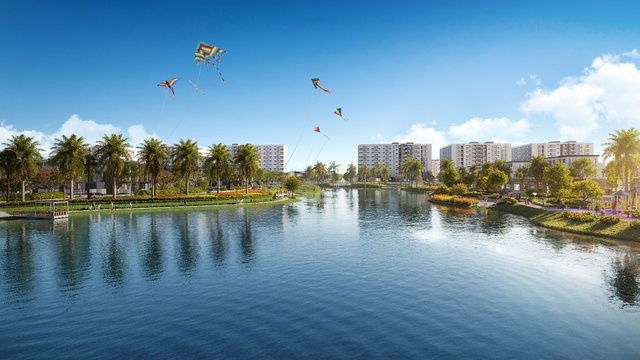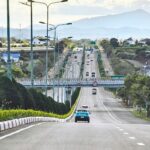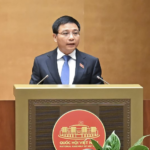Strategic Leverage to Propel Can Tho’s Breakthrough
The National Assembly officially passed the resolution to merge Can Tho City, Hau Giang Province, and Soc Trang Province on June 12, 2025, bringing the total area of the new city to 6,360 sq. km with a population of approximately 4.2 million people. This historical milestone lays the foundation for the formation of a “super inter-regional metropolis” with a new stature, converging the three essential pillars of development in the Mekong Delta: industry and logistics, maritime economy, and high-tech agriculture. Along with the ongoing infrastructure investments in highways, railways, deep-sea ports, and international airports, the new Can Tho City will serve as the central driving force for economic and urban development in the region.
Moreover, public investment continues to be a crucial catalyst for the market. According to the Ministry of Transport, the Mekong Delta region is witnessing simultaneous investments in nine key transport infrastructure projects with a total capital of over VND 106,000 billion. Among these, the expressways, including Can Tho-Ca Mau, Chau Doc-Can Tho-Soc Trang, and the second Can Tho Bridge and Rach Mieu Bridge, are strategic constructions that contribute to reducing travel time, lowering logistics costs, and enhancing inter-regional connectivity.

Can Tho’s Real Estate Enters a New Cycle of Sustainable Development
A review of the first half of 2025 reveals a robust recovery in Can Tho’s real estate market, marking the beginning of a new cycle of sustainable growth. The Vietnam Real Estate Association forecasts an improvement in property supply in the Mekong Delta region in 2025, with approximately 20,000 products on offer, focusing on Long An and Can Tho. Legal clarity and sustainable value are prioritized in this cycle, with land plots with separate ownership certificates or houses with rental potential being quickly absorbed by the market. Prices in Can Tho have increased by 5-8% compared to the same period last year, particularly in the Cai Rang district and along the Hau River axis. This area has seen price hikes of over 10%, and this upward trend is expected to continue in the coming quarters as infrastructure development accelerates.
Investment Appeal of the Integrated Township Nam Long II Central Lake
Amid this market upswing, Nam Long II Central Lake stands out as a prominent project in the Mekong Delta region. Strategically located in the center of Cai Rang district, adjacent to Ninh Kieu district, and directly connected to the Hau River axis, which is envisioned as the new development core of Can Tho, Nam Long II Central Lake boasts a prime location just a few minutes’ drive from the administrative center and with convenient access to key expressways.
Developed as an integrated township across 43.8 hectares, the project excels with its transparent legal status – 100% of the products in phases 1 and 2 have red books (ownership certificates) – and a harmonious master plan, amenities, and architecture. Notably, it is one of the few projects in the area allocating over 60% of its area for green spaces, water bodies, and public utilities.

Nam Long II Central Lake Attracts Investors with its Integrated Township Model
The project offers over 30 synchronized internal utilities, including a 3-hectare scenic lake park, sports facilities, schools, healthcare, commercial areas, and community playgrounds. With its meticulously designed integrated township concept, Nam Long II Central Lake presents an ideal living environment for both owner-occupiers and investors, aligning with the market’s growing preference for green, amenity-rich, and sustainably valuable urban areas.
Another competitive advantage of Nam Long II Central Lake (Nam Long 2 Residential Area (Lot 9A) in Nam Can Tho Urban Area, Hung Thanh Ward, Cai Rang District, Can Tho City) is its competitive pricing and flexible financial policies, including bank loan support of up to 65% and interest-free periods of up to 24 months. These incentives alleviate financial pressure and enhance ownership opportunities, especially in the context of persistently low-interest rates.
With the renowned 33-year track record of Nam Long Group in urban development nationwide and their over two decades of presence in Can Tho, the project assures investors of unwavering commitment to timely delivery and quality, instilling absolute confidence in its solid foundation and long-term vision.
As Can Tho embarks on a new development cycle fueled by inter-regional infrastructure and well-planned urbanization, projects like Nam Long II Central Lake, distinguished by their legal clarity, exemplary planning, and value appreciation potential, are poised to attract sustainable and long-term investment flows to the economic hub of the Mekong Delta region.
Grand Opening of The Metropolitan Bac Giang: A Vibrant Urban Park Complex
On June 22, 2025, the grand opening of The Metropolitan Bac Giang’s Central Park Complex took place, drawing hundreds of excited customers and investors. The event marked a pivotal moment for the mixed-use urban development, showcasing its vision of a vibrant and thriving community.
Unveiling the Tycoon Behind the $780 Million Project: Slashing Travel Time from Ho Chi Minh City to Dalat to Just 3 Hours
The bustling metropolis of Ho Chi Minh City and the idyllic hill station of Dalat are now closer than ever, thanks to a newly constructed expressway. This strategic route, a testament to innovative engineering and efficient transportation planning, has successfully bridged the distance between these two vibrant destinations.
“Innovating for an End to Plastic Pollution.”
The finalists of the 2025 Innovation Challenge on Plastics showcased a diverse range of approaches to tackling plastic pollution. From bio-substitute materials and circular economic models to waste management technologies and smart waste management platforms, these initiatives offered a holistic view of addressing the plastic waste crisis. Additionally, the presence of policy-driven initiatives promoting green consumer behavior added a unique dimension to the cohort, underlining the importance of a multi-faceted strategy in combating this global issue.













































